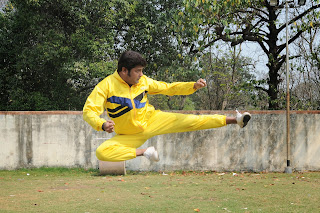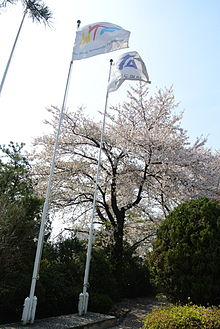Man
by nature has instinct to preserve his own life as well as his race,
and therefore engages in physical activities either consciously or
unconsciously. Man cannot do without physical motions that he grows and
developed on them, regardless of time and space. In ancient times people
had no means other than the bare hands and body to defend themselves;
so they naturally developed the bare-hand fighting techniques. Even at
times when arms were developed as defensive or offensive means, people
continued to enjoy the bare-hand fighting techniques for the purpose of
building physical strength as well as showing off through matches at
rituals of tribal communities.

In
the early days of the Korean peninsula, there were three tribes, each
enjoying warrior's martial art contests during the ritual seasons. At
the time, people learned techniques from their experiences of fighting
against the beasts whose defensive and offensive motions were also the
subject of analysis. It is believed that this was exactly the true
grounding of today's Taekwondo, which names have descended from "Subak",
"Taekkyon" and so on.
In the latter part of ancient times on
the Korean peninsula, three kingdoms were rivaling among them for the
hegemony. They were Koguryo, Paekje and Shilla all indulged in growing
national strength with trained warriors. Therefore, the Korean history
tells that there were military personalities among the well-known
prominent national leaders of the three kingdoms, which proves the
military tendency of ruling hierarchy.
As a result, youth warriors were
organized, such as "Hwarangdo" in Shilla and "Chouisonin" in Koguryo,
which both adopted martial art training as one of the important subjects
of learning. A known martial art book of the days, called
"Muyedobo-Tongji" wrote "Taekwondo is the basis of martial art, enabling
one to build strength by using the hand and foot freely and training
arms and legs as well as the body to adaptable to any critical
situations," which means Taekwondo was already prevalent in that age.
Thus, it can be easily assumed that Taekwondo was originated from the
days of tribal communities on the Korean peninsula.
Shilla kingdom founded in B.C. 57 on the
southeastern part of Korea, and Koguryo founded in B.C. 37 on the
northern part of Korea along Yalu river, both made great efforts to
raise their youngsters into strong warriors called "hwarang" and
"sunbae" respectively, certainly with Taekwondo as one of the principal
subjects of physical training.
Koguryo's Training and Taekkyon
Koguryo was founded on the northern part
of Korea, surrounded by hostile Han [Chinese] tribes in the north.
Therefore, in its early days, the kingdom organized a strong warrior
corps called "Sunbae" in its attempt to consolidate power.

According
to the scholars, a man of virtue who never recoils from a fight means
"sunbae", which is a member of the warrior corps. Later, the chronicle
of the Old Chosun Dynasty described the lift of Koguryo days, saying;
"people gathered on march 10 every year at a site of ritual, where they
enjoyed a sword dance, archery, Taekkyon contests and so on," implying
that Taekkyon was one of the popular events for the ritual in the
Koguryo days. It also said "sunbae" lived in groups, learning history
and literary arts at home and going out to construct roads and
fortresses for the benefits of society, always devoting themselves to
the nations.
Therefore, it was natural that Koguryo
put the priority of interests on the Taekkyon which was the basis of
martial arts, as can be proven by the wall paintings discovered at tombs
of Koguryo days. A mural painting at the Samsil tomb shows two warriors
engaged in a face-to-face match in Taekkyon stance, and a third at the
same tomb shows the scene of Korean wrestling bout [Ssireum], clearly
distinguishing it from Taekkyon. It can be assumed from the painting of
Taekkyon match that the dead were either a Taekkyon practical or the
subject of condolence with dances and martial art.
Shilla's "Hwarang" and Taekkyon
The Kingdom of Shilla was founded on the
southeastern part of the Korean peninsula where there were no immediate
threats from outside, but along with the birth of Paekje Kingdom on its
west flank and the start of invasions by Koguryo from the north, Shilla
was impelled to arm itself with development of martial arts.
In fact, "hwarangdo" is the typical
example of Shilla's martial arts, which is an assimilation of Koguryo's
"sunbae" system. The youth group hwarangdo were well trained with the
senses of filial piety, loyalty to the kingdom and sacrificial devotion
to society to become important personalities for the rein of the
kingdom. Notable among them were Kim Yu-Shin and Kim Chun-Chu that made
definite contributions to the unification of those three kingdoms.
The chronicle of Old Chosun described
the life of hwarangs, members of hwarangdo: "hwarang were selected by
the kingdom through contests and, after selection, they lived together
in a group, learning, exercising subak, fencing and horse-riding, and
sometimes enjoyed various games of communities, working on emergency
aids and construction of fortresses and roads, and they were always
ready to sacrifice their lives at the time of war."

Hwarangs
were particularly influenced by the Buddhistic disciplines and
therefore the bronze statues of a Kumgang Yoksa [a man of great physical
strength] currently exhibited at the Kyongju Museum clearly indicate
that martial arts were practiced at temples by showing a strong man's
bare-hand defensive and offensive stances.
Especially the shape of a fist shown on
the statue of Kumgang Yoksa exactly resembles that of a "jungkwon"
[proper fist] in the contemporary term of Taekwondo. The statue also
shows "pyon jumok " [flat fist] and the use of legs, which are seen in
today's Taekwondo.
It is really noticeable that in the
Shilla epoch the terms "subak" [hand techniques] and "taekkyon" appear
together, signifying that both hand and foot techniques were used in
martial arts as shown in today's Taekwondo.
Taekkyon transmitted from Koguryo to Shilla
As the art of taekkyon was popularized
in Koguryo, it was also handed down to Silla, which is justified by the
following points of view;
- "Hwarang"(or sonrang) in Silla has the
same meaning with the word "sonbae" in Koguryo by indicating both the
youth warrior's corps from their etymological origins.
- Both Hwarang and sonbae had the same organizations and hierarchical structure with each other.
- According to historical, as sonbaes in
Koguryo used to compete in taekkyon games at the time of their national
festivals, Hwarangs in Silla also played taekkyon games (subak, dokkyoni
or taekkyoni) at such festivals as "palkwanhoe" and "hankawi" , thus
systematically developing the ancient fighting techniques into the
taekkyon(or sonbae) as the basis of martial arts by around a.d.200. from
the 4th century the Hwarangs took the takkyon lesson as a systemized
martial art at their learning houses to make it also popularized among
ordinary people so much so that their techniques were depicted on the
mural paintings of ancient warrior tombs. Again, it is also true that
taekkyon, coming down to Silla, was further developed into a school of
martial art with the division of techniques, i ,e bare-hand techniques
and foot techniques, which can be proved by the fact that both hand and
foot techniques art clearly shown in the ancient sculptures buddlistic
statues.
 Martial
art experts began opening Taekwondo gymnasiums all over the country and
after the end of Korean War (1950-1953) Taekwondo was popularized among
the dan-grade black-belters within the country, also dispatching about
2,000 Taekwondo masters to more than 100 countries.
Martial
art experts began opening Taekwondo gymnasiums all over the country and
after the end of Korean War (1950-1953) Taekwondo was popularized among
the dan-grade black-belters within the country, also dispatching about
2,000 Taekwondo masters to more than 100 countries.






